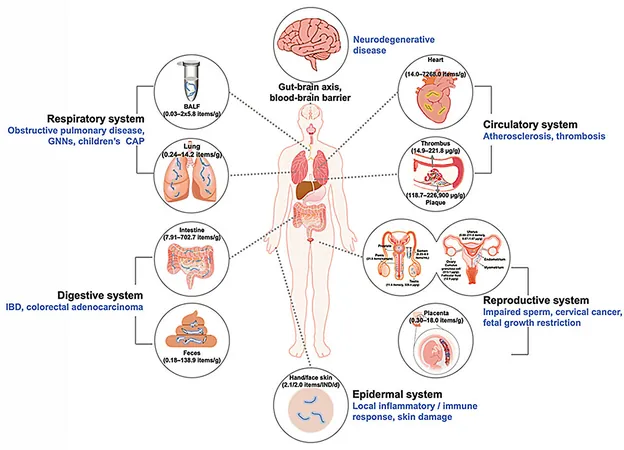
Alarming Discovery: Microplastics Detected in Human Organs Linked to Serious Health Issues
2024-12-30
Author: Rajesh
Introduction
Recent research spearheaded by Zhejiang Agriculture and Forestry University in China has unveiled startling findings regarding the presence of micro and nanoplastics (MNPs) in human tissues. This comprehensive metadata analysis indicates a troubling correlation between the concentration of these tiny plastic particles and various health conditions, raising serious concerns about the pervasive impact of plastic pollution on human health.
The Rise of Plastic Usage
The history of plastic usage has skyrocketed from 1.5 million metric tons in the 1950s to an astonishing 390.7 million metric tons by 2021. As our reliance on plastic products surged, so did the contamination of our environment with microscopic plastic debris. This pollution has been shown to infiltrate soil, waterways, and ultimately, the food chain which leads to accumulation in human tissues.
Lack of Standardized Detection Methods
Despite the alarming implications, there is a glaring lack of standardized methods to detect and quantify microplastics in human organs. The need for reliable data linking MNP exposure to specific health outcomes has never been more urgent to assess risks and design effective intervention strategies.
Key Findings from the Study
In the pivotal study titled “Mapping micro(nano)plastics in various organ systems: Their emerging links to human diseases?” published in TrAC Trends in Analytical Chemistry, researchers systematically reviewed 61 investigations focused on MNP detection in human tissues, alongside a substantial 840 articles assessing the toxicological mechanisms of MNPs.
Methodologies Employed
The methodologies employed included advanced spectroscopy, microscopy, and pyrolysis-gas chromatography/mass spectrometry, enabling the identification of various polymer types across different tissues. Toxicological research also utilized cell models and animal studies to investigate outcomes like oxidative stress and inflammation triggered by MNP exposure.
Widespread Detection in Human Organs
Worryingly, MNPs were detected in an extensive range of human organs including skin, arteries, veins, bone marrow, reproductive organs, and the digestive system, from saliva all the way to feces. Alarmingly, the respiratory system displayed high levels of microplastics as well, with particles frequently found in lung tissue and bronchoalveolar lavage fluids.
Health Implications of MNP Exposure
The research identified a significant correlation between the concentration of microplastics and specific health disorders such as inflammatory bowel disease, thrombosis, cervical cancer, and uterine fibroids. Toxicological experiments suggested that MNP exposure could instigate oxidative stress, disrupt mitochondrial function, provoke inflammation, and even result in cell death across various cell types. Furthermore, concerns about neurodegenerative diseases arise when considering MNPs' ability to cross the blood-brain barrier.
Causality Questions
A particularly noteworthy finding of the study was that microplastic concentrations appeared markedly higher in tissues suffering from lesions compared to healthy ones. This raises the critical question of causality: do MNPs foster inflammation and damage leading to lesions, or do existing lesions absorb more microplastics?
Conclusion and Future Directions
While researchers emphasize that current findings do not establish a clear cause-and-effect relationship, they highlight potential pathways for future exploration in this urgent area of public health.
Challenges of Mitigation
Currently, there are no established methods for removing microplastics from either the environment or human bodies. While environmental mitigation strategies are being explored, addressing the diverse sizes and chemistries of embedded particles in living tissues presents a daunting challenge.
Call to Action
As awareness grows, this research shines a light on the hidden health risks posed by microplastics and stresses the immediate need for decisive action and further investigation to protect human health from the detriments of plastic pollution. The question remains: How many more health issues are lurking beneath the surface as we continue to neglect the plastic crisis?



 Brasil (PT)
Brasil (PT)
 Canada (EN)
Canada (EN)
 Chile (ES)
Chile (ES)
 Česko (CS)
Česko (CS)
 대한민국 (KO)
대한민국 (KO)
 España (ES)
España (ES)
 France (FR)
France (FR)
 Hong Kong (EN)
Hong Kong (EN)
 Italia (IT)
Italia (IT)
 日本 (JA)
日本 (JA)
 Magyarország (HU)
Magyarország (HU)
 Norge (NO)
Norge (NO)
 Polska (PL)
Polska (PL)
 Schweiz (DE)
Schweiz (DE)
 Singapore (EN)
Singapore (EN)
 Sverige (SV)
Sverige (SV)
 Suomi (FI)
Suomi (FI)
 Türkiye (TR)
Türkiye (TR)
 الإمارات العربية المتحدة (AR)
الإمارات العربية المتحدة (AR)